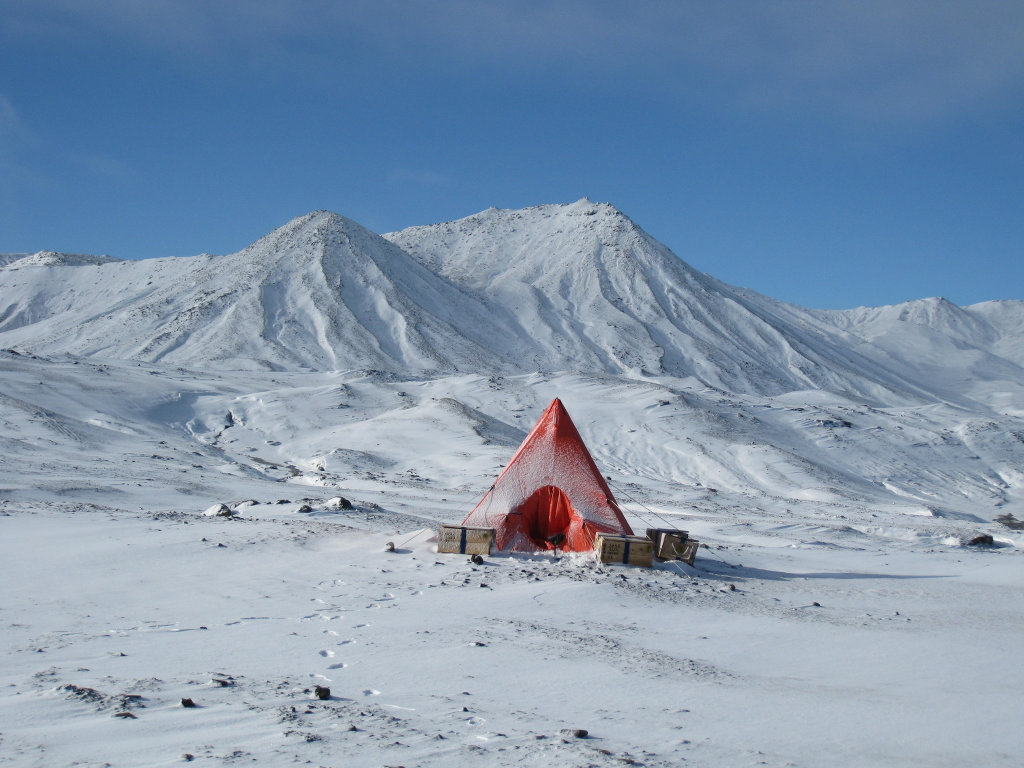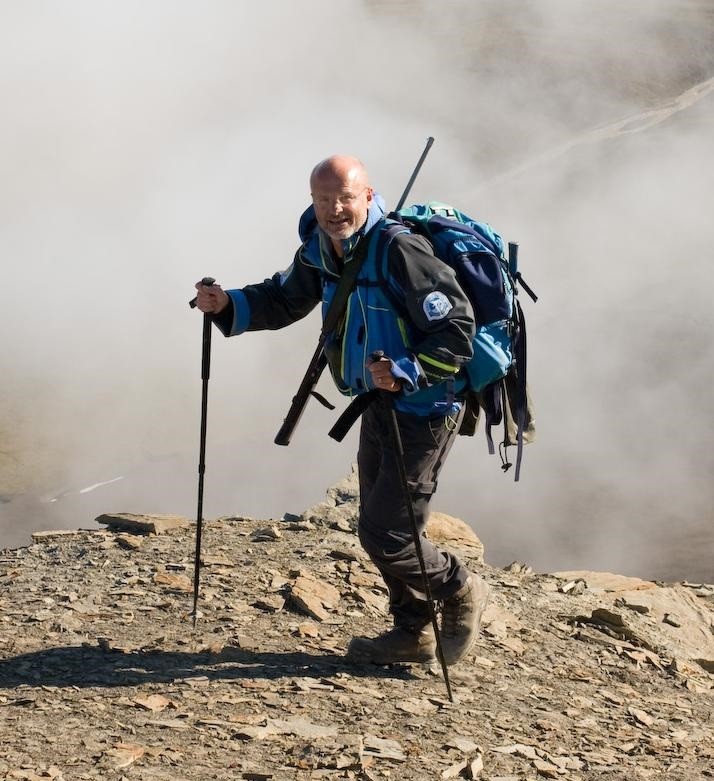Jonas Hagström hiking up Mount Rekstentoppen on Spitsbergen in 2008. Photo by Mikael Axelsson
The Linnaeus Apostle Anton Rolandsson Martin, the first Swedish Polar Explorer – but where on Spitsbergen did he land?
As the travel accounts of Linnaeus Apostles are made available in English for the first time the world is able to follow these daring young men that were certainly driven by what fuel most young men – adventure and the chance to explore, but in this case also combined with an urge to unlock the secrets of the natural world.
This important scientific era did not catch my eye as it hid among all the other boring facts in the history books in school and my eyes were not open to this interesting period in Swedish history until I was in my forties.

My tent after the snow storm. Seymour Island, Antarctica in 2011. Photo by Jonas Hagström
Being a city boy raised in Stockholm my contact with nature came at our summer house on the other side of Sweden, the West Coast. From the age of five I have travelled here every summer, greeted by the salty winds sweeping in from The North Sea/Skagerack. Where my fascination for nature came from I don't know. There is no natural science background in our family but my father and I often watched nature programs on TV together. As I began to explore the surroundings bringing home my finds and asking for the name of some seashell, plant or bug, my parents, unable to provide an answer, wisely bought me small field guides instead. Soon I started to see the resemblance between different species and the concept of taxonomy was revealed to me – did young Linnaeus experience the same thing as he as a boy roamed the fields in Råshult?
A major influence was the TV series featuring the French marine biologist Jacques Cousteau cruising the seas in his boat Calypso. Inspired by him and my own explorations snorkeling at our country house together with occasional family trips to tropical countries with their coral reefs, made me decide on a career in marine biology. At the age of seventeen I got myself a diving certificate as a start.
There was however, a parallel, competing field of interest. My cousins lived in a small town in central Sweden which lies in the crater of Europe's largest meteor impact – Siljan. In the downfaulted ring structure you find well preserved invertebrate fossils from the Ordovician period, some 460 million years old. Fossil collecting here combined with a fab for Science fiction made me dream of alien worlds, both in space and in our planets past.
So, what should I go for – colourful coral reefs in warm seas or dusty quarries? In the end I chose the latter, partly by a reluctance to kill animals just for the privilege to look at their insides, something hard to avoid as a biology student – yes, I know, I am a softie.
Studying geosciences at Stockholm University meant frequent excursions to outcrops and quarries around Sweden and Europe. I learned to love the smell of wet limestone and cherished my new ability to read the rocks and thereby reveal their history. My first paper was devoted to acritarchs – fossil plankton from the dawn of animals – 510 million years back in time. This was followed by a licentiate on spores from early land plants, a research field I was supposed to pursue. But I never got to finish my PhD as I was offered a position in 2000 as a senior assistant of the fossil collections at the Swedish Museum of Natural History – an offer too good to refuse!
My first task was to register fossil specimens in a database. Soon I came to the material collected by the Swedish polar expeditions of the 20th century – a hundred years after the Apostles' journeys. As a representative of the African species
Homo sapiens, I felt I lived on the northern extreme of our specie's range and always went to warmer places for holidays. But as I began to read about the expeditions I was captured by the adventures of these "Polar Apostles" – Torell, Nathorst and the Nordenskiölds embarking on journeys to the white spots of the map in the far north and south. Using wooden ships, at best equipped with weak steam engines, they ventured into the unknown risking, and sometimes loosing, their lives – a fate also met by almost half of Linnaeus' students. The more I read of the high latitudes the more I got determined to go there myself – I was bitten by the Polar bug!

An Argentine colleague climbing a fossil shell bed on Seymour Island, Antarctica in 2011. In the background Cockburn Island and Admirality Sound. Photo by Jonas Hagström
When I write this in the summer of 2015 I have so far managed to go on three expeditions to Svalbard, or Spitsbergen which is the more traditional name. I have collected
Triassic ichthyosaurs and hunted in vain for Paleocene mammals on this island. The rigour of camping in the cold and the threat of polar bear attacks is compensated by stunning views, fresh air and interesting geology. In 2011 I even got a chance I thought would stay a dream – to participate in an expedition to Seymour Island, Antarctica! On this continent the first scientific collecting of fossils took place during the dramatic Swedish South Pole Expedition of 1901-03. On our expedition we collected bones of giant penguins and flying birds, fish, shark teeth, starfish, crabs etc, all about 40 million years old. The top find was, however, a whale jaw that messed up the hitherto accepted theory on whale evolution – our specimen was way too old for that level of development!
The same year I opened a drawer in the fossil collections of our museum and found a forgotten and unloved ammonite lacking the crucial information of where it had been collected. There was a bleached label on the specimen and thought I could make out the words "obtained from Martin". As I thought the specimen had some likeness to specimens I had seen in the polar collections I googled "Martin + Spetsbergen". The first result was a Wikipedia text on Anton Rolandsson Martin who in 1758 was asked by Linnaeus to sail with a Swedish whaler to Spitsbergen! Was this ammonite collected by one of the Apostles!? Reading Martin's travel account I learned that due to severe ice conditions and the purpose of the voyage – whaling in the open sea – he only managed to get ashore for two hours on some unidentified islet. Of the few specimens Martin collected only one, supposedly survived till today – a herbarium specimen of
Cochlearia officinalis, scurvy grass. There was not enough information in Martin's texts or on the specimen label to pinpoint the exact landing place. As I told my problems to a colleague in the geology department, Jörgen Langhof, he said "Martin? I think we have a rock sample he collected on Spitsbergen". Only Jörgen would remember seeing a small paper written in 1920 which identifies a piece of quartzite in the museum collections as the same one Martin brought back to Sweden in 1758! This proved to be a crucial piece of evidence in determining the landing place as this rock type is only found in a limited area of Spitsbergen which also encompass very few candidates for the Martin’s islet.
To verify the landing place of Sweden's first polar explorer you would, however have to go there and compare Martins notes on the islet and
the rock specimen with the real thing. Perhaps a
BRIDGE BUILDER EXPEDITION organised by the IK Foundation would do the trick?




 An Argentine colleague climbing a fossil shell bed on Seymour Island, Antarctica in 2011. In the background Cockburn Island and Admirality Sound. Photo by Jonas Hagström
An Argentine colleague climbing a fossil shell bed on Seymour Island, Antarctica in 2011. In the background Cockburn Island and Admirality Sound. Photo by Jonas Hagström Sveaskog, Stockholm, Sweden
Sveaskog, Stockholm, Sweden



